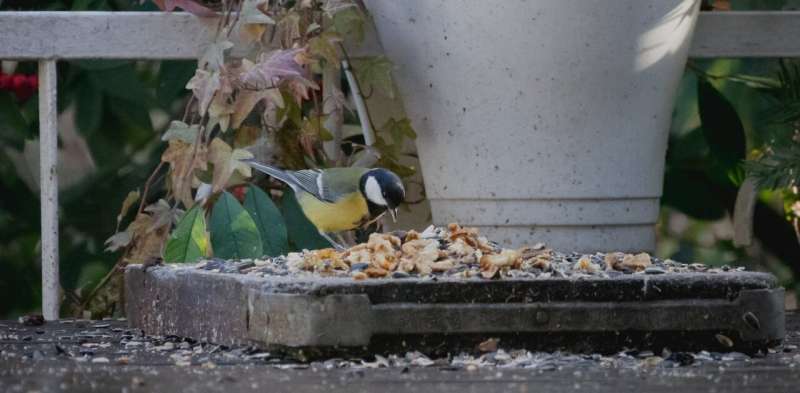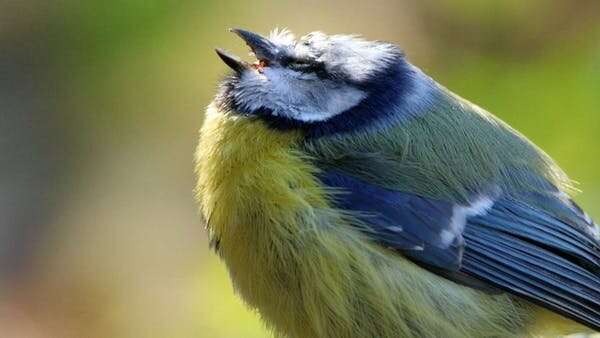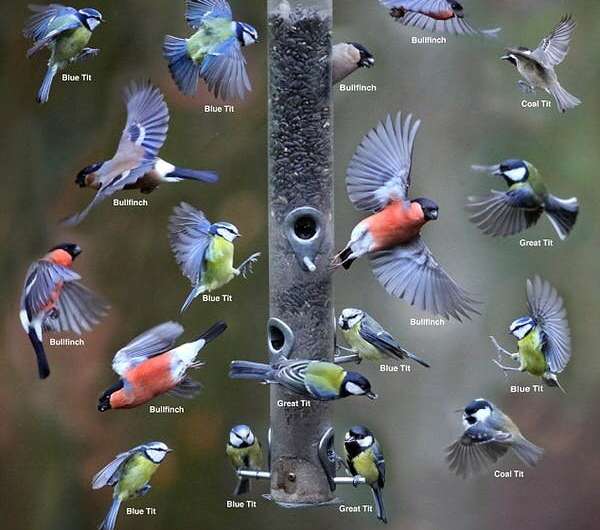Why you may need to encourage social distancing around your bird feeder

People in Britain feed up to 196 million birds a year with 60,000 tonnes of bird food, at a total cost of £300 million. All those garden feeders have helped boost populations of dozens of bird species, including the garden regular, the blue tit, whose numbers have increased by 26% in the last 50 years.
But could our benevolence be harming birds? In Germany, a fatal pneumonia-like illness has been affecting several thousand blue tits. Laboratory tests confirmed that the organism responsible for the outbreak was a bacteria called Suttonella ornithocola, which is well-established in British blue tit populations too, with cases of the disease usually peaking in spring time. Symptoms include loss of appetite, breathing problems, ungroomed feathers and a willingness to approach humans, while healthy birds would tend to avoid us.
S. ornithocola was first isolated from the lungs of a blue tit in the 1990s and has since been found in other tit species, although the blue tit seems to be the most susceptible. In the UK during springtime, the disease is thought to be responsible for as much as 13% of all blue tit deaths.
Birds and zoonotic diseases
Garden birds are known to carry other infectious viruses, bacteria and fungi, including the West Nile Virus, Salmonella and Cryptococcus. These microbes are zoonotic, which means that given the appropriate conditions, they could spread from animals to humans. In 2019, Cryptococcus was linked to the death of a ten-year-old boy in Glasgow, after he inhaled the fungi from pigeon droppings.

Although native blue tits only migrate within the UK, there are many other garden birds such as the willow warbler and the swallow which migrate thousands of miles to and from the country. There is already evidence of these wild bird migrations helping spread diseases among birds and to humans, such as the West Nile Virus in the US, Salmonella in Sweden and Pseudomonas in Italy. The ability of these birds to travel long distances in short periods of time brings further risk, as heavy physical stress combined with a suppressed immune system could cause the rapid spread of infectious diseases.
While there are medicines available to treat infections such as S. ornithocola, it's not possible to effectively treat wild birds. Giving animals antibiotics might even cause more harm than good, as it risks creating superbugs that can resist antibiotics to which they were once sensitive. In the EU alone, superbugs cause 670,000 deaths every year.
Garden Wildlife Health, a monitoring project run by the UK's biggest bird protection and conservation charities, is encouraging the public to look out for signs that birds in the vicinity are unwell, so that experts can keep a national database of wildlife disease incidents. Symptoms to look out for include lethargy—when birds are quiet and inactive, or fail to fly away when approached—fluffed up plumages, the irregular loss of feathers and skin lesions (which are usually evident around the beak and on the claws).
Garden feeders and water baths can act as infectious disease hotspots for birds, as they bring lots of individuals into close contact. The best thing bird enthusiasts can do is to keep these areas clean and safe. This includes encouraging diseased birds to disperse by reducing the amount of food or stopping feeding temporarily if lots of affected birds are visiting the same feeder. In other words, encourage diseased birds to adopt social distancing.

Top tips
- Clean and disinfect bird feeders regularly. The RSPB suggests a 5% disinfectant solution.
- Use separate utensils for cleaning the feeders and avoid bringing these into the house.
- Obtain fresh food from accredited sources.
- Feed in moderation, so that feeders are emptied every couple of days.
- Move your feeders to a new location at least once a month to prevent the accumulation of faeces and food remains underneath.
- If you have water containers (including drinking troughs and water baths), these must be rinsed out daily.
- If you see any sick or dead birds, including blue tits, report them to Garden Wildlife Health.
Provided by The Conversation
This article is republished from The Conversation under a Creative Commons license. Read the original article.![]()

















